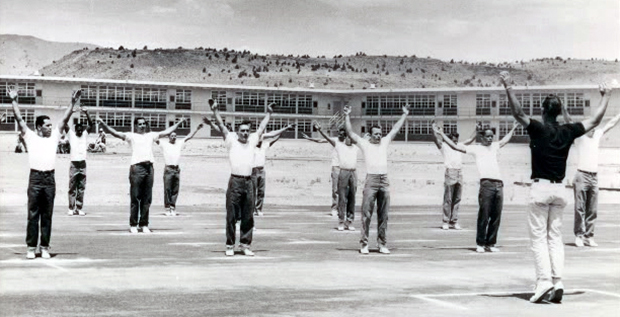
As the ‘Post-War Boom’ spread throughout the country, many rural areas felt very little effect. The excitement was mainly centered around the cities. Agriculture and forest-based economies went along as usual for the most part. Of course, the post-war building boom did help both industries. But in Lassen County in the 1950’s, there were still many homes without electricity, telephones, and, of course, televisions.
At the same time, the state’s prison system, filled with antiquated facilities and equipment, was past its capacity. The search was on for new prison sites.
In 1953, local officials and citizens, particularly businessmen, began to promote the idea of having a prison for Lassen County. Goodwin Knight, prior to his taking office as Governor, declared that he favored the locale because it would add to the economic stability of the area and because of the abundant agricultural land and adequate water supply. This new prison would be a medium security facility, based on the idea of rehabilitation through education. It would be the center hub of a network of conservation camps, where inmates would learn to protect and preserve our forests. Most essentially, they would become wildland fire fighters. The prison would also have instruction in cooking, laundry, upholstery, construction trades, and even an autobody shop, along with many other opportunities. The hope was to make the inmate’s transition back into society more of an easy one.
By October of 1953, a group of citizens, mainly from the ranching community, began protesting the idea of a prison, citing; loss of agricultural land, not wanting to be called a ‘prison community’, chance of inmate escape, etc. Even with this objection, by November of 1953, all local organizations; the American Legion, Monticola Club, 20-30 Club, the Soroptomist and others, fully supported the idea.
In January of 1954, a group of state officials came to inspect the proposed site, seven miles from town, and hold a public meeting in Memorial Hall to hear concerns. By this time, it seems there was no turning back. The deal was apparently moving ahead. As extra impetus, Lassen County District Attorney Stanley Arnold pressed Governor Goodwin Knight. He reported that Lassen County was suffering economic hardships. He mentioned that there was talk of succession to Nevada and asks that the state improve U.S. Highway 395 and place the new prison here. The Lassen site was one of eight in consideration.
The effort paid off. The decision was made, and Lassen County, good or bad, was to get the new facility. In August of 1960, Johnson, Drake & Piper, Inc. of Oakland submitted the winning bid of $8,140,000, and was to have it ready for occupancy by mid-1962. The building plans came from the State Division of Architecture: Two facing 608-man units separated from each other by a core of central facilities such as a mess hall, kitchen, and laundry. Each of the two units is divided into 16-man dormitories, that is the same number of men as on a camp crew. The prison will be the hub of an accelerated conservation camp program with 30 year-round camps. Merle Schneckloth was chosen to be the first superintendent.
Susanville’s economy would receive a boost more than $3,000,000 per year when the new conservation center was opened in 1962. Now, Senator Stan Arnold, said there will be more than 200 new employees, including 140 for inmate supervision and 110 or more with maintenance, cooking, education, administration, and medical care. This was the boon that the local businesses yearned for.
Now, houses were to be built to accommodate the new employees. Teachers needed to be hired, stores prepared to expand, and almost every facet of the economy was set to take off.
In mid-September of 1962, Governor Brown flew into Herlong and traveled to the site to lead the groundbreaking ceremony for the prison. He took control of a 35-ton earth mover to signal the beginning of construction. The prison was to employ 250 people and have an annual payroll of $1.6 million. But most importantly, the new concept of a prison was to eliminate the need for any more new prisons. Authorities said that the conservation camp concept would turn idle men into useful workers.
With normal ‘glitches’, the construction took about a year longer than expected to complete, and costs exceeded the budget. But by February 1963, the first inmates began to arrive. As promised, the local economy exploded. Many places felt the strain, especially housing and schools, but all-in-all, it worked out. Lassen County began to thrive.
Within ten years of the opening of the new California Conservation Center, things had changed. The political climate and new laws limited the number of the state’s inmate population. Part of the local prison sat vacant, and there was a real danger of it being closed. With this news leaking out into the community, property values in and around Susanville took a steep decline. Local citizens were stunned to think of losing the facility.
Luckily, in April of 1973, Governor Brown proposed an increase in prison funds to keep Susanville’s correctional facility open another year and to open vacant wings at CCC and San Quentin. The efforts paid off, and the prison was kept open. Today, being a ‘Prison Town’ may have disadvantages, but it also has many advantages for our county.







